Unit 5 Accounting Principles: Informing Decisions and Performance
VerifiedAdded on 2023/06/09
|17
|4631
|198
Report
AI Summary
This report provides a critical evaluation of accounting's role in informing decision-making, considering organizational, stakeholder, and societal needs within complex operating environments. It addresses the purpose of accounting functions within regulatory and ethical constraints. The report includes an evaluation of financial statements to assess organizational performance, using various measures and benchmarks. It computes financial ratios, analyzes them, and discusses the benefits and limitations of budgets and budgetary planning, focusing on Duck Cafe. The report also includes a prepared cash budget for Duck Cafe and justifies budgetary control solutions to ensure efficient resource deployment. The report analyzes accounting principles, financial statements, and budgeting. It also contains a cash budget, financial ratio calculations, and discussions on budgetary control.
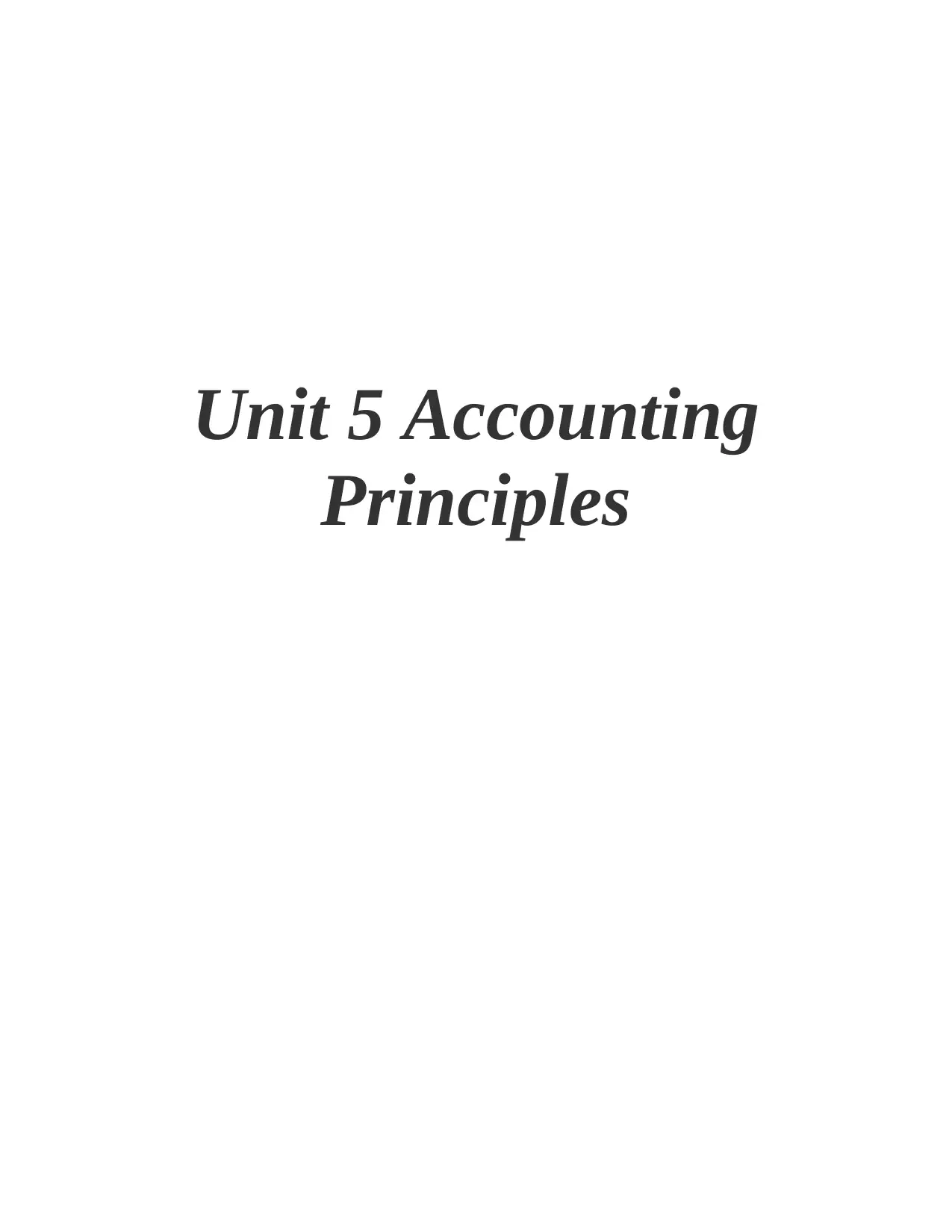
Unit 5 Accounting
Principles
Principles
Paraphrase This Document
Need a fresh take? Get an instant paraphrase of this document with our AI Paraphraser
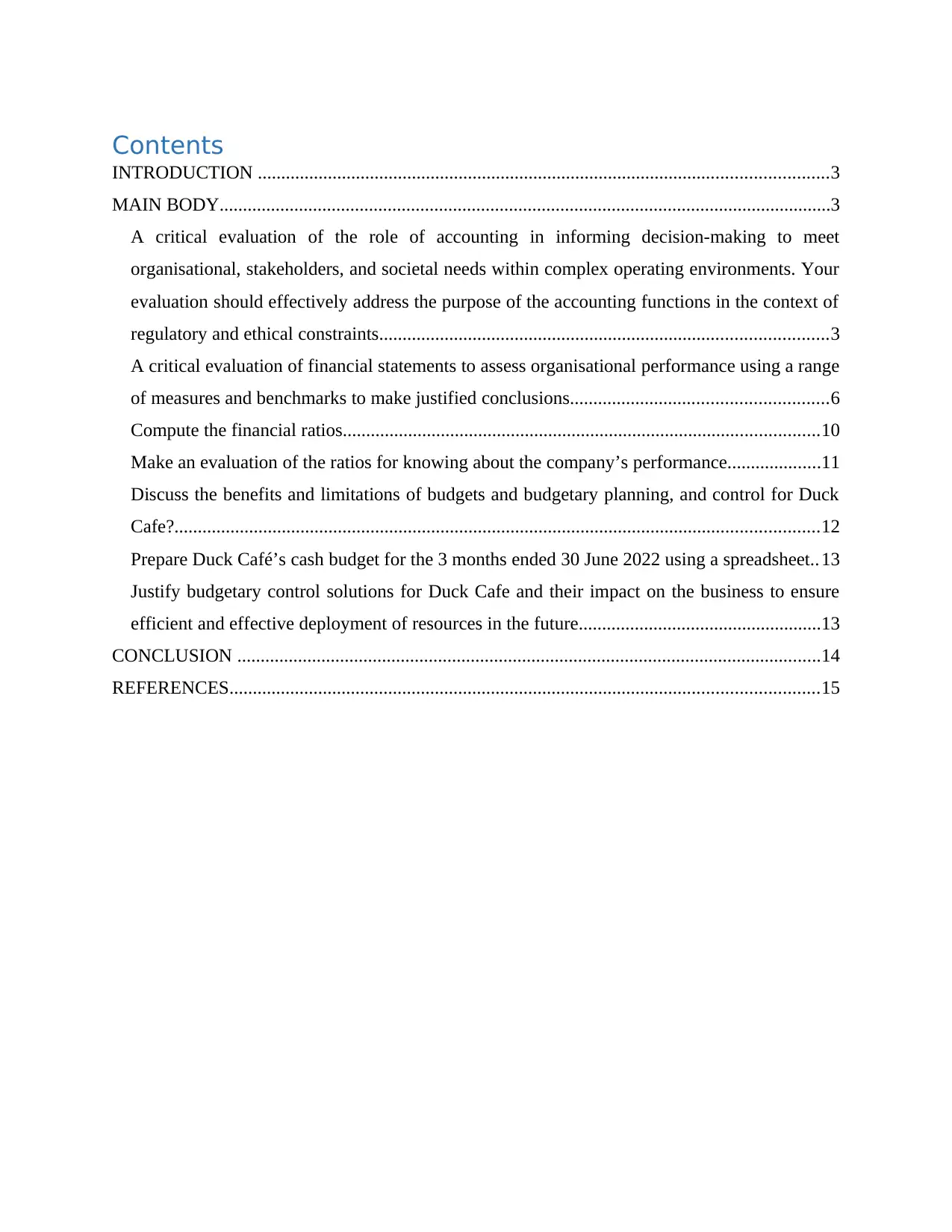
Contents
INTRODUCTION ..........................................................................................................................3
MAIN BODY...................................................................................................................................3
A critical evaluation of the role of accounting in informing decision-making to meet
organisational, stakeholders, and societal needs within complex operating environments. Your
evaluation should effectively address the purpose of the accounting functions in the context of
regulatory and ethical constraints................................................................................................3
A critical evaluation of financial statements to assess organisational performance using a range
of measures and benchmarks to make justified conclusions.......................................................6
Compute the financial ratios......................................................................................................10
Make an evaluation of the ratios for knowing about the company’s performance....................11
Discuss the benefits and limitations of budgets and budgetary planning, and control for Duck
Cafe?..........................................................................................................................................12
Prepare Duck Café’s cash budget for the 3 months ended 30 June 2022 using a spreadsheet..13
Justify budgetary control solutions for Duck Cafe and their impact on the business to ensure
efficient and effective deployment of resources in the future....................................................13
CONCLUSION .............................................................................................................................14
REFERENCES..............................................................................................................................15
INTRODUCTION ..........................................................................................................................3
MAIN BODY...................................................................................................................................3
A critical evaluation of the role of accounting in informing decision-making to meet
organisational, stakeholders, and societal needs within complex operating environments. Your
evaluation should effectively address the purpose of the accounting functions in the context of
regulatory and ethical constraints................................................................................................3
A critical evaluation of financial statements to assess organisational performance using a range
of measures and benchmarks to make justified conclusions.......................................................6
Compute the financial ratios......................................................................................................10
Make an evaluation of the ratios for knowing about the company’s performance....................11
Discuss the benefits and limitations of budgets and budgetary planning, and control for Duck
Cafe?..........................................................................................................................................12
Prepare Duck Café’s cash budget for the 3 months ended 30 June 2022 using a spreadsheet..13
Justify budgetary control solutions for Duck Cafe and their impact on the business to ensure
efficient and effective deployment of resources in the future....................................................13
CONCLUSION .............................................................................................................................14
REFERENCES..............................................................................................................................15
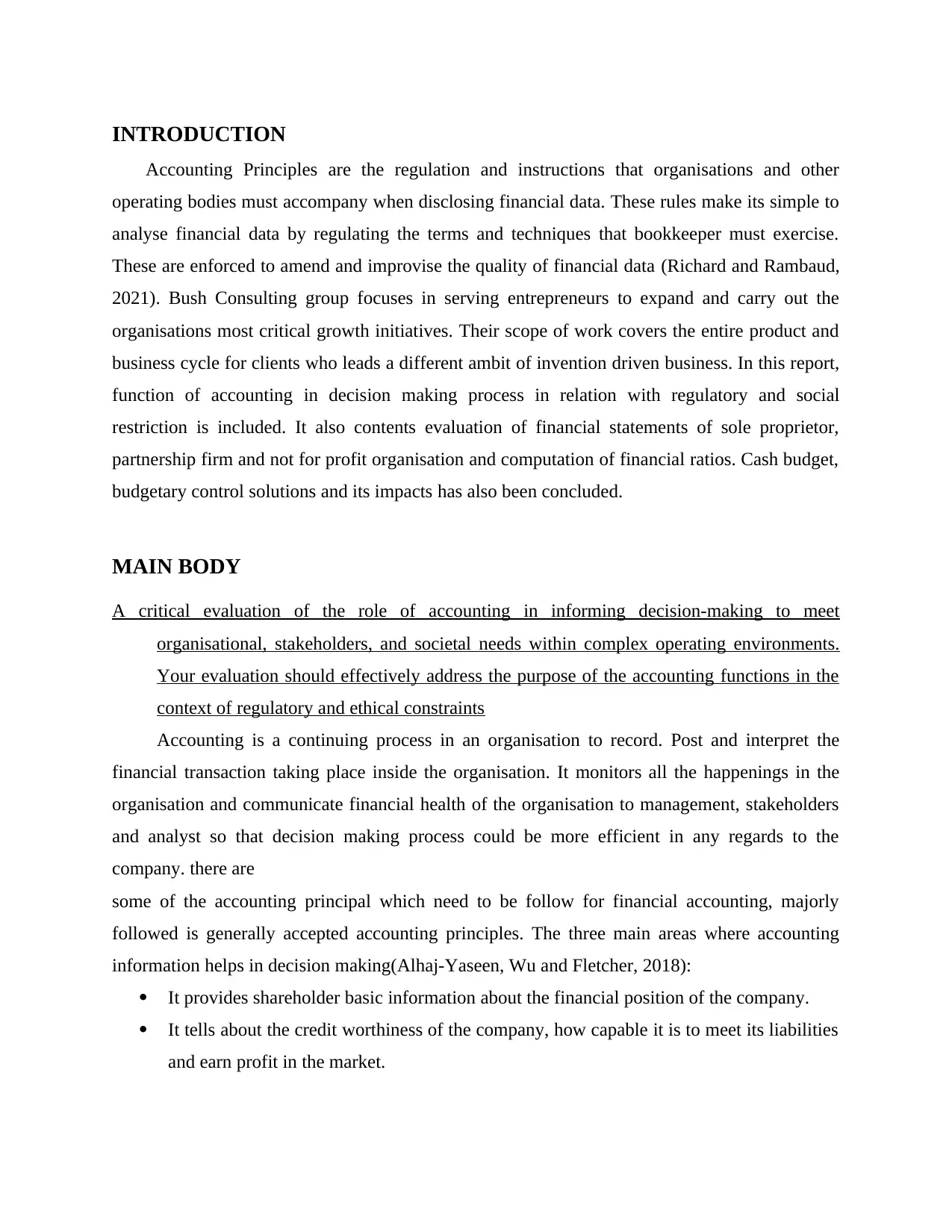
INTRODUCTION
Accounting Principles are the regulation and instructions that organisations and other
operating bodies must accompany when disclosing financial data. These rules make its simple to
analyse financial data by regulating the terms and techniques that bookkeeper must exercise.
These are enforced to amend and improvise the quality of financial data (Richard and Rambaud,
2021). Bush Consulting group focuses in serving entrepreneurs to expand and carry out the
organisations most critical growth initiatives. Their scope of work covers the entire product and
business cycle for clients who leads a different ambit of invention driven business. In this report,
function of accounting in decision making process in relation with regulatory and social
restriction is included. It also contents evaluation of financial statements of sole proprietor,
partnership firm and not for profit organisation and computation of financial ratios. Cash budget,
budgetary control solutions and its impacts has also been concluded.
MAIN BODY
A critical evaluation of the role of accounting in informing decision-making to meet
organisational, stakeholders, and societal needs within complex operating environments.
Your evaluation should effectively address the purpose of the accounting functions in the
context of regulatory and ethical constraints
Accounting is a continuing process in an organisation to record. Post and interpret the
financial transaction taking place inside the organisation. It monitors all the happenings in the
organisation and communicate financial health of the organisation to management, stakeholders
and analyst so that decision making process could be more efficient in any regards to the
company. there are
some of the accounting principal which need to be follow for financial accounting, majorly
followed is generally accepted accounting principles. The three main areas where accounting
information helps in decision making(Alhaj-Yaseen, Wu and Fletcher, 2018):
It provides shareholder basic information about the financial position of the company.
It tells about the credit worthiness of the company, how capable it is to meet its liabilities
and earn profit in the market.
Accounting Principles are the regulation and instructions that organisations and other
operating bodies must accompany when disclosing financial data. These rules make its simple to
analyse financial data by regulating the terms and techniques that bookkeeper must exercise.
These are enforced to amend and improvise the quality of financial data (Richard and Rambaud,
2021). Bush Consulting group focuses in serving entrepreneurs to expand and carry out the
organisations most critical growth initiatives. Their scope of work covers the entire product and
business cycle for clients who leads a different ambit of invention driven business. In this report,
function of accounting in decision making process in relation with regulatory and social
restriction is included. It also contents evaluation of financial statements of sole proprietor,
partnership firm and not for profit organisation and computation of financial ratios. Cash budget,
budgetary control solutions and its impacts has also been concluded.
MAIN BODY
A critical evaluation of the role of accounting in informing decision-making to meet
organisational, stakeholders, and societal needs within complex operating environments.
Your evaluation should effectively address the purpose of the accounting functions in the
context of regulatory and ethical constraints
Accounting is a continuing process in an organisation to record. Post and interpret the
financial transaction taking place inside the organisation. It monitors all the happenings in the
organisation and communicate financial health of the organisation to management, stakeholders
and analyst so that decision making process could be more efficient in any regards to the
company. there are
some of the accounting principal which need to be follow for financial accounting, majorly
followed is generally accepted accounting principles. The three main areas where accounting
information helps in decision making(Alhaj-Yaseen, Wu and Fletcher, 2018):
It provides shareholder basic information about the financial position of the company.
It tells about the credit worthiness of the company, how capable it is to meet its liabilities
and earn profit in the market.
⊘ This is a preview!⊘
Do you want full access?
Subscribe today to unlock all pages.

Trusted by 1+ million students worldwide
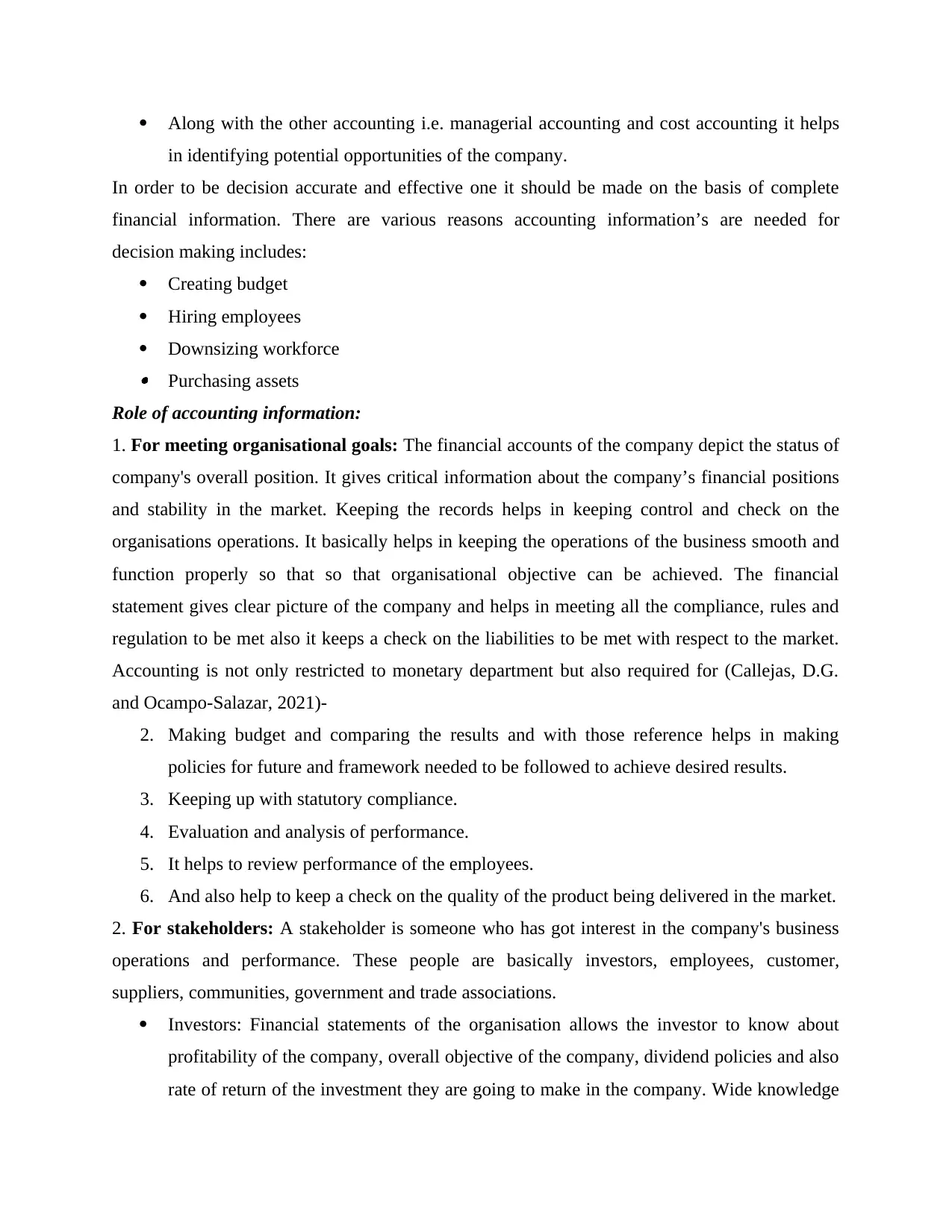
Along with the other accounting i.e. managerial accounting and cost accounting it helps
in identifying potential opportunities of the company.
In order to be decision accurate and effective one it should be made on the basis of complete
financial information. There are various reasons accounting information’s are needed for
decision making includes:
Creating budget
Hiring employees
Downsizing workforce Purchasing assets
Role of accounting information:
1. For meeting organisational goals: The financial accounts of the company depict the status of
company's overall position. It gives critical information about the company’s financial positions
and stability in the market. Keeping the records helps in keeping control and check on the
organisations operations. It basically helps in keeping the operations of the business smooth and
function properly so that so that organisational objective can be achieved. The financial
statement gives clear picture of the company and helps in meeting all the compliance, rules and
regulation to be met also it keeps a check on the liabilities to be met with respect to the market.
Accounting is not only restricted to monetary department but also required for (Callejas, D.G.
and Ocampo-Salazar, 2021)-
2. Making budget and comparing the results and with those reference helps in making
policies for future and framework needed to be followed to achieve desired results.
3. Keeping up with statutory compliance.
4. Evaluation and analysis of performance.
5. It helps to review performance of the employees.
6. And also help to keep a check on the quality of the product being delivered in the market.
2. For stakeholders: A stakeholder is someone who has got interest in the company's business
operations and performance. These people are basically investors, employees, customer,
suppliers, communities, government and trade associations.
Investors: Financial statements of the organisation allows the investor to know about
profitability of the company, overall objective of the company, dividend policies and also
rate of return of the investment they are going to make in the company. Wide knowledge
in identifying potential opportunities of the company.
In order to be decision accurate and effective one it should be made on the basis of complete
financial information. There are various reasons accounting information’s are needed for
decision making includes:
Creating budget
Hiring employees
Downsizing workforce Purchasing assets
Role of accounting information:
1. For meeting organisational goals: The financial accounts of the company depict the status of
company's overall position. It gives critical information about the company’s financial positions
and stability in the market. Keeping the records helps in keeping control and check on the
organisations operations. It basically helps in keeping the operations of the business smooth and
function properly so that so that organisational objective can be achieved. The financial
statement gives clear picture of the company and helps in meeting all the compliance, rules and
regulation to be met also it keeps a check on the liabilities to be met with respect to the market.
Accounting is not only restricted to monetary department but also required for (Callejas, D.G.
and Ocampo-Salazar, 2021)-
2. Making budget and comparing the results and with those reference helps in making
policies for future and framework needed to be followed to achieve desired results.
3. Keeping up with statutory compliance.
4. Evaluation and analysis of performance.
5. It helps to review performance of the employees.
6. And also help to keep a check on the quality of the product being delivered in the market.
2. For stakeholders: A stakeholder is someone who has got interest in the company's business
operations and performance. These people are basically investors, employees, customer,
suppliers, communities, government and trade associations.
Investors: Financial statements of the organisation allows the investor to know about
profitability of the company, overall objective of the company, dividend policies and also
rate of return of the investment they are going to make in the company. Wide knowledge
Paraphrase This Document
Need a fresh take? Get an instant paraphrase of this document with our AI Paraphraser
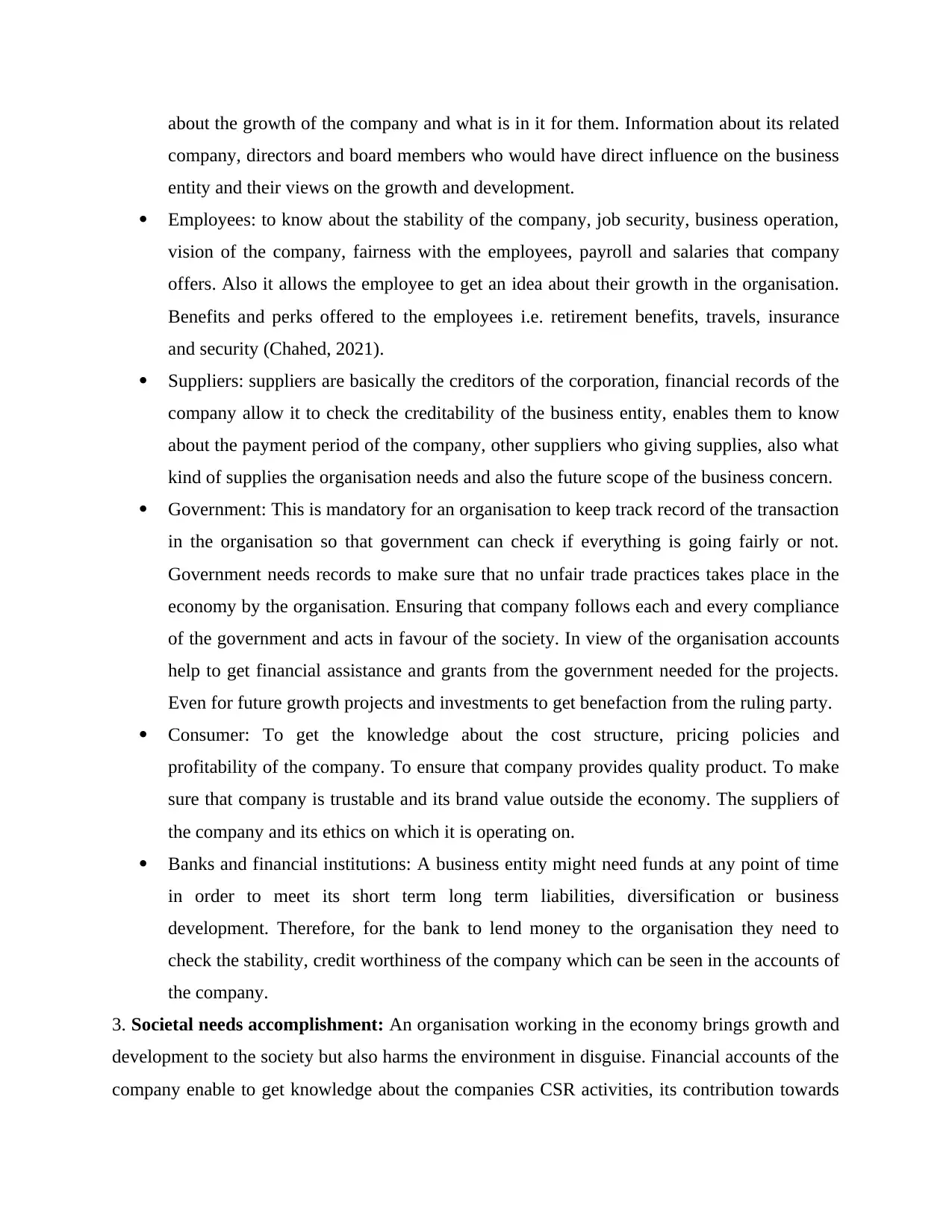
about the growth of the company and what is in it for them. Information about its related
company, directors and board members who would have direct influence on the business
entity and their views on the growth and development.
Employees: to know about the stability of the company, job security, business operation,
vision of the company, fairness with the employees, payroll and salaries that company
offers. Also it allows the employee to get an idea about their growth in the organisation.
Benefits and perks offered to the employees i.e. retirement benefits, travels, insurance
and security (Chahed, 2021).
Suppliers: suppliers are basically the creditors of the corporation, financial records of the
company allow it to check the creditability of the business entity, enables them to know
about the payment period of the company, other suppliers who giving supplies, also what
kind of supplies the organisation needs and also the future scope of the business concern.
Government: This is mandatory for an organisation to keep track record of the transaction
in the organisation so that government can check if everything is going fairly or not.
Government needs records to make sure that no unfair trade practices takes place in the
economy by the organisation. Ensuring that company follows each and every compliance
of the government and acts in favour of the society. In view of the organisation accounts
help to get financial assistance and grants from the government needed for the projects.
Even for future growth projects and investments to get benefaction from the ruling party.
Consumer: To get the knowledge about the cost structure, pricing policies and
profitability of the company. To ensure that company provides quality product. To make
sure that company is trustable and its brand value outside the economy. The suppliers of
the company and its ethics on which it is operating on.
Banks and financial institutions: A business entity might need funds at any point of time
in order to meet its short term long term liabilities, diversification or business
development. Therefore, for the bank to lend money to the organisation they need to
check the stability, credit worthiness of the company which can be seen in the accounts of
the company.
3. Societal needs accomplishment: An organisation working in the economy brings growth and
development to the society but also harms the environment in disguise. Financial accounts of the
company enable to get knowledge about the companies CSR activities, its contribution towards
company, directors and board members who would have direct influence on the business
entity and their views on the growth and development.
Employees: to know about the stability of the company, job security, business operation,
vision of the company, fairness with the employees, payroll and salaries that company
offers. Also it allows the employee to get an idea about their growth in the organisation.
Benefits and perks offered to the employees i.e. retirement benefits, travels, insurance
and security (Chahed, 2021).
Suppliers: suppliers are basically the creditors of the corporation, financial records of the
company allow it to check the creditability of the business entity, enables them to know
about the payment period of the company, other suppliers who giving supplies, also what
kind of supplies the organisation needs and also the future scope of the business concern.
Government: This is mandatory for an organisation to keep track record of the transaction
in the organisation so that government can check if everything is going fairly or not.
Government needs records to make sure that no unfair trade practices takes place in the
economy by the organisation. Ensuring that company follows each and every compliance
of the government and acts in favour of the society. In view of the organisation accounts
help to get financial assistance and grants from the government needed for the projects.
Even for future growth projects and investments to get benefaction from the ruling party.
Consumer: To get the knowledge about the cost structure, pricing policies and
profitability of the company. To ensure that company provides quality product. To make
sure that company is trustable and its brand value outside the economy. The suppliers of
the company and its ethics on which it is operating on.
Banks and financial institutions: A business entity might need funds at any point of time
in order to meet its short term long term liabilities, diversification or business
development. Therefore, for the bank to lend money to the organisation they need to
check the stability, credit worthiness of the company which can be seen in the accounts of
the company.
3. Societal needs accomplishment: An organisation working in the economy brings growth and
development to the society but also harms the environment in disguise. Financial accounts of the
company enable to get knowledge about the companies CSR activities, its contribution towards
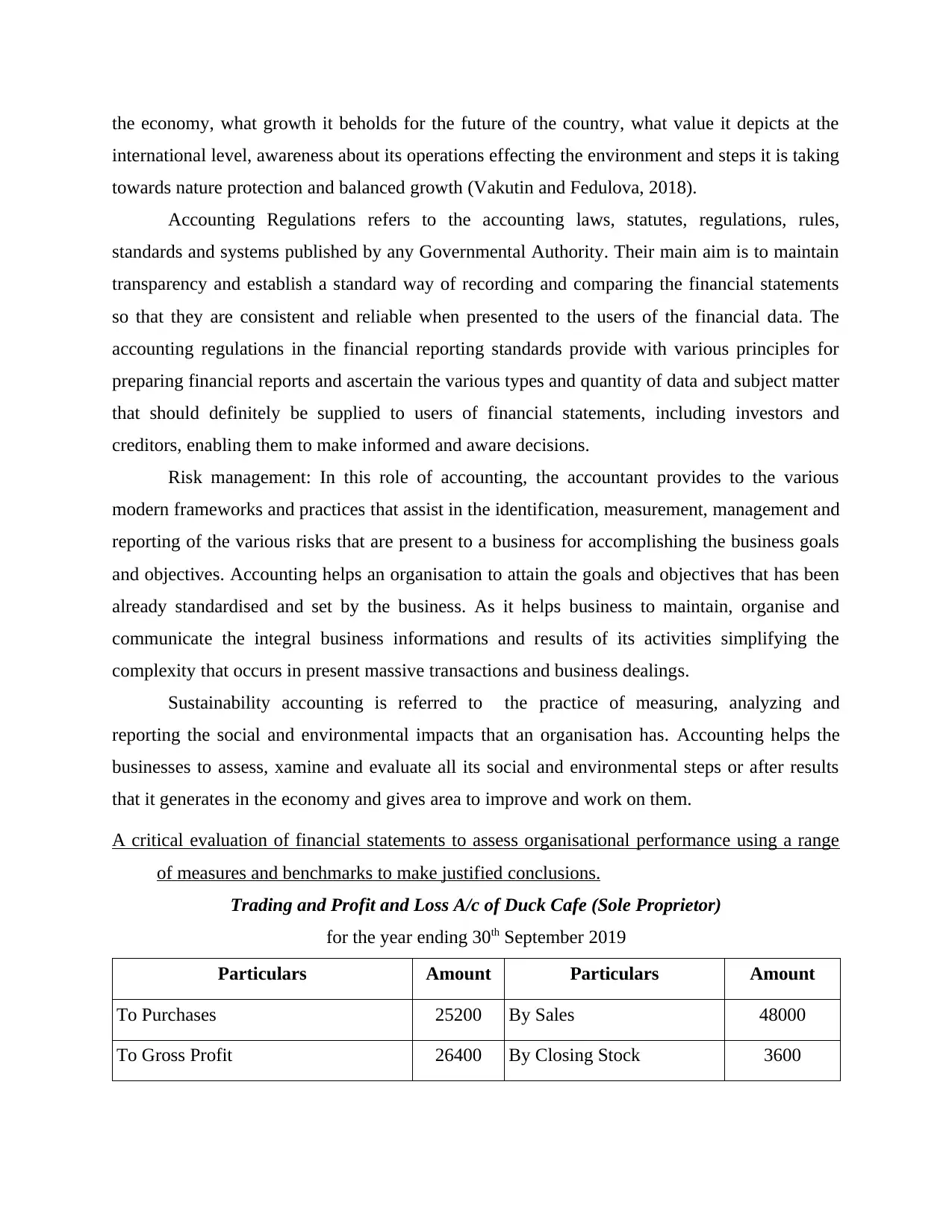
the economy, what growth it beholds for the future of the country, what value it depicts at the
international level, awareness about its operations effecting the environment and steps it is taking
towards nature protection and balanced growth (Vakutin and Fedulova, 2018).
Accounting Regulations refers to the accounting laws, statutes, regulations, rules,
standards and systems published by any Governmental Authority. Their main aim is to maintain
transparency and establish a standard way of recording and comparing the financial statements
so that they are consistent and reliable when presented to the users of the financial data. The
accounting regulations in the financial reporting standards provide with various principles for
preparing financial reports and ascertain the various types and quantity of data and subject matter
that should definitely be supplied to users of financial statements, including investors and
creditors, enabling them to make informed and aware decisions.
Risk management: In this role of accounting, the accountant provides to the various
modern frameworks and practices that assist in the identification, measurement, management and
reporting of the various risks that are present to a business for accomplishing the business goals
and objectives. Accounting helps an organisation to attain the goals and objectives that has been
already standardised and set by the business. As it helps business to maintain, organise and
communicate the integral business informations and results of its activities simplifying the
complexity that occurs in present massive transactions and business dealings.
Sustainability accounting is referred to the practice of measuring, analyzing and
reporting the social and environmental impacts that an organisation has. Accounting helps the
businesses to assess, xamine and evaluate all its social and environmental steps or after results
that it generates in the economy and gives area to improve and work on them.
A critical evaluation of financial statements to assess organisational performance using a range
of measures and benchmarks to make justified conclusions.
Trading and Profit and Loss A/c of Duck Cafe (Sole Proprietor)
for the year ending 30th September 2019
Particulars Amount Particulars Amount
To Purchases 25200 By Sales 48000
To Gross Profit 26400 By Closing Stock 3600
international level, awareness about its operations effecting the environment and steps it is taking
towards nature protection and balanced growth (Vakutin and Fedulova, 2018).
Accounting Regulations refers to the accounting laws, statutes, regulations, rules,
standards and systems published by any Governmental Authority. Their main aim is to maintain
transparency and establish a standard way of recording and comparing the financial statements
so that they are consistent and reliable when presented to the users of the financial data. The
accounting regulations in the financial reporting standards provide with various principles for
preparing financial reports and ascertain the various types and quantity of data and subject matter
that should definitely be supplied to users of financial statements, including investors and
creditors, enabling them to make informed and aware decisions.
Risk management: In this role of accounting, the accountant provides to the various
modern frameworks and practices that assist in the identification, measurement, management and
reporting of the various risks that are present to a business for accomplishing the business goals
and objectives. Accounting helps an organisation to attain the goals and objectives that has been
already standardised and set by the business. As it helps business to maintain, organise and
communicate the integral business informations and results of its activities simplifying the
complexity that occurs in present massive transactions and business dealings.
Sustainability accounting is referred to the practice of measuring, analyzing and
reporting the social and environmental impacts that an organisation has. Accounting helps the
businesses to assess, xamine and evaluate all its social and environmental steps or after results
that it generates in the economy and gives area to improve and work on them.
A critical evaluation of financial statements to assess organisational performance using a range
of measures and benchmarks to make justified conclusions.
Trading and Profit and Loss A/c of Duck Cafe (Sole Proprietor)
for the year ending 30th September 2019
Particulars Amount Particulars Amount
To Purchases 25200 By Sales 48000
To Gross Profit 26400 By Closing Stock 3600
⊘ This is a preview!⊘
Do you want full access?
Subscribe today to unlock all pages.

Trusted by 1+ million students worldwide
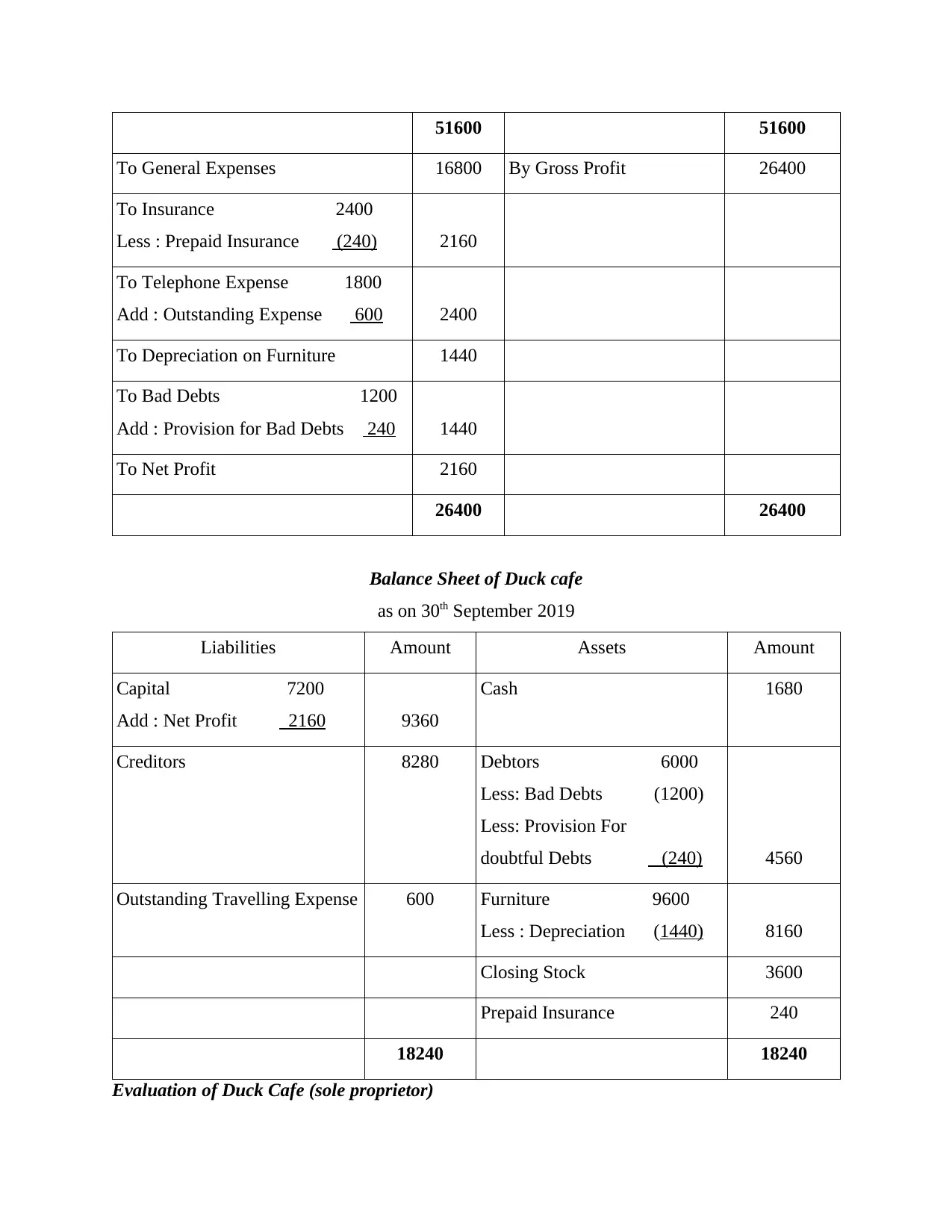
51600 51600
To General Expenses 16800 By Gross Profit 26400
To Insurance 2400
Less : Prepaid Insurance (240) 2160
To Telephone Expense 1800
Add : Outstanding Expense 600 2400
To Depreciation on Furniture 1440
To Bad Debts 1200
Add : Provision for Bad Debts 240 1440
To Net Profit 2160
26400 26400
Balance Sheet of Duck cafe
as on 30th September 2019
Liabilities Amount Assets Amount
Capital 7200
Add : Net Profit 2160 9360
Cash 1680
Creditors 8280 Debtors 6000
Less: Bad Debts (1200)
Less: Provision For
doubtful Debts (240) 4560
Outstanding Travelling Expense 600 Furniture 9600
Less : Depreciation (1440) 8160
Closing Stock 3600
Prepaid Insurance 240
18240 18240
Evaluation of Duck Cafe (sole proprietor)
To General Expenses 16800 By Gross Profit 26400
To Insurance 2400
Less : Prepaid Insurance (240) 2160
To Telephone Expense 1800
Add : Outstanding Expense 600 2400
To Depreciation on Furniture 1440
To Bad Debts 1200
Add : Provision for Bad Debts 240 1440
To Net Profit 2160
26400 26400
Balance Sheet of Duck cafe
as on 30th September 2019
Liabilities Amount Assets Amount
Capital 7200
Add : Net Profit 2160 9360
Cash 1680
Creditors 8280 Debtors 6000
Less: Bad Debts (1200)
Less: Provision For
doubtful Debts (240) 4560
Outstanding Travelling Expense 600 Furniture 9600
Less : Depreciation (1440) 8160
Closing Stock 3600
Prepaid Insurance 240
18240 18240
Evaluation of Duck Cafe (sole proprietor)
Paraphrase This Document
Need a fresh take? Get an instant paraphrase of this document with our AI Paraphraser
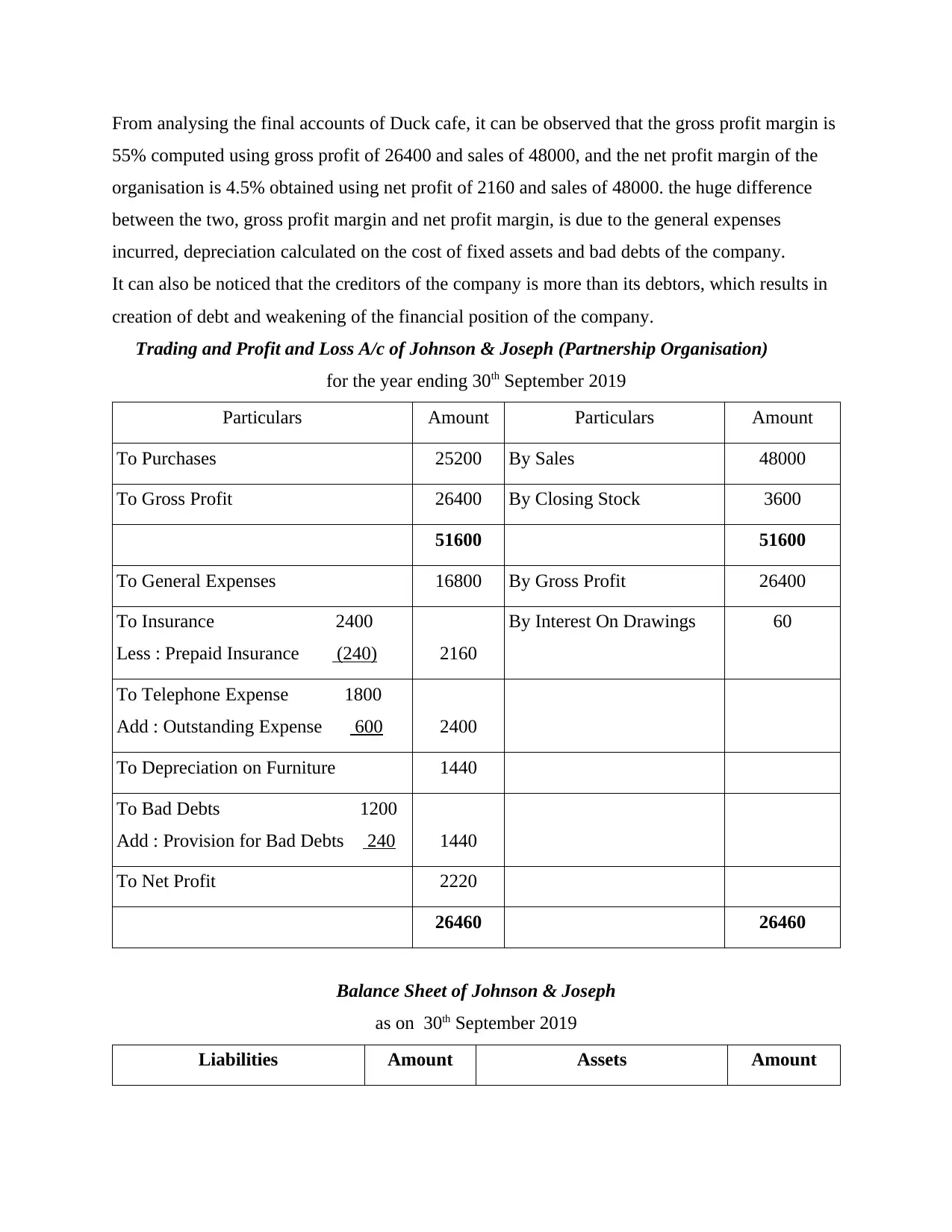
From analysing the final accounts of Duck cafe, it can be observed that the gross profit margin is
55% computed using gross profit of 26400 and sales of 48000, and the net profit margin of the
organisation is 4.5% obtained using net profit of 2160 and sales of 48000. the huge difference
between the two, gross profit margin and net profit margin, is due to the general expenses
incurred, depreciation calculated on the cost of fixed assets and bad debts of the company.
It can also be noticed that the creditors of the company is more than its debtors, which results in
creation of debt and weakening of the financial position of the company.
Trading and Profit and Loss A/c of Johnson & Joseph (Partnership Organisation)
for the year ending 30th September 2019
Particulars Amount Particulars Amount
To Purchases 25200 By Sales 48000
To Gross Profit 26400 By Closing Stock 3600
51600 51600
To General Expenses 16800 By Gross Profit 26400
To Insurance 2400
Less : Prepaid Insurance (240) 2160
By Interest On Drawings 60
To Telephone Expense 1800
Add : Outstanding Expense 600 2400
To Depreciation on Furniture 1440
To Bad Debts 1200
Add : Provision for Bad Debts 240 1440
To Net Profit 2220
26460 26460
Balance Sheet of Johnson & Joseph
as on 30th September 2019
Liabilities Amount Assets Amount
55% computed using gross profit of 26400 and sales of 48000, and the net profit margin of the
organisation is 4.5% obtained using net profit of 2160 and sales of 48000. the huge difference
between the two, gross profit margin and net profit margin, is due to the general expenses
incurred, depreciation calculated on the cost of fixed assets and bad debts of the company.
It can also be noticed that the creditors of the company is more than its debtors, which results in
creation of debt and weakening of the financial position of the company.
Trading and Profit and Loss A/c of Johnson & Joseph (Partnership Organisation)
for the year ending 30th September 2019
Particulars Amount Particulars Amount
To Purchases 25200 By Sales 48000
To Gross Profit 26400 By Closing Stock 3600
51600 51600
To General Expenses 16800 By Gross Profit 26400
To Insurance 2400
Less : Prepaid Insurance (240) 2160
By Interest On Drawings 60
To Telephone Expense 1800
Add : Outstanding Expense 600 2400
To Depreciation on Furniture 1440
To Bad Debts 1200
Add : Provision for Bad Debts 240 1440
To Net Profit 2220
26460 26460
Balance Sheet of Johnson & Joseph
as on 30th September 2019
Liabilities Amount Assets Amount
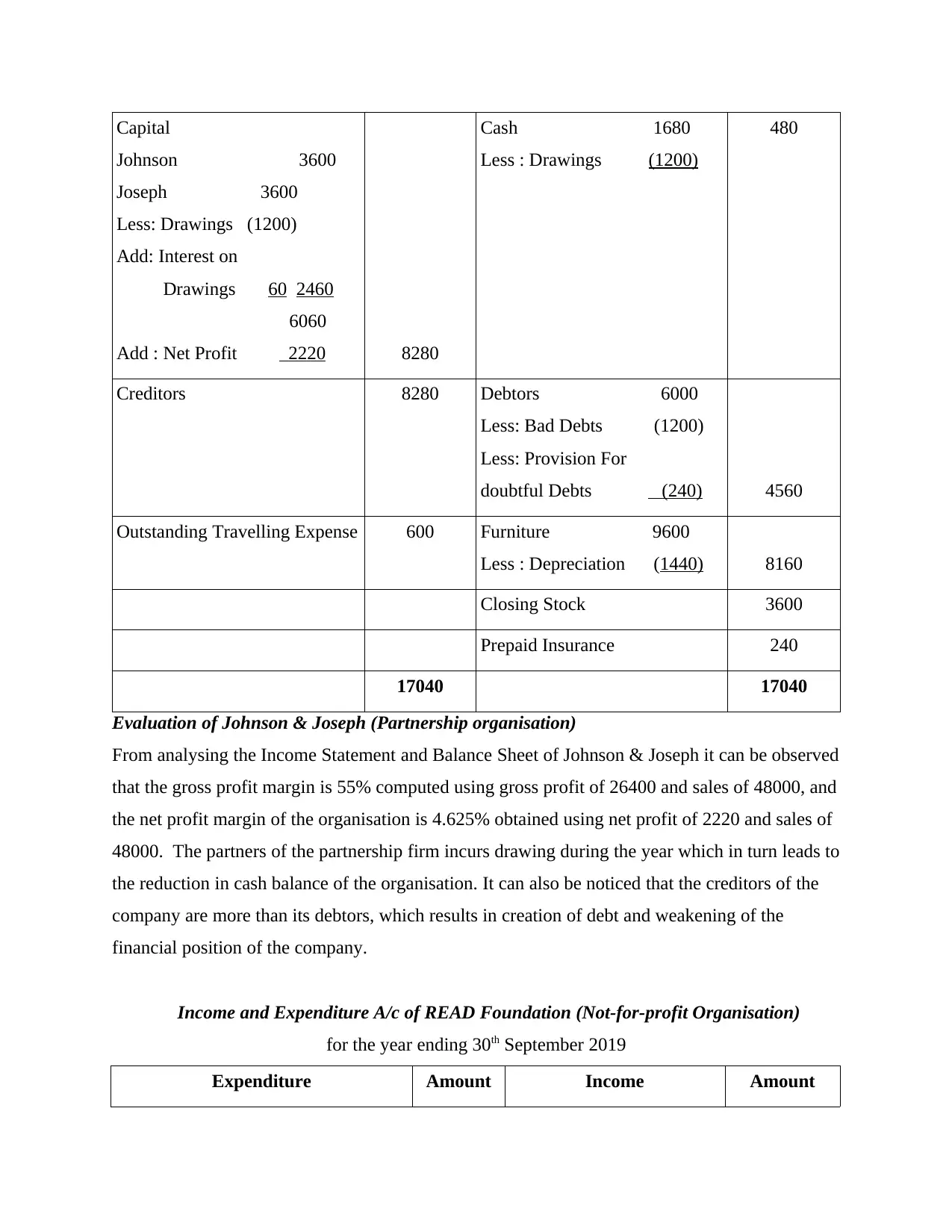
Capital
Johnson 3600
Joseph 3600
Less: Drawings (1200)
Add: Interest on
Drawings 60 2460
6060
Add : Net Profit 2220 8280
Cash 1680
Less : Drawings (1200)
480
Creditors 8280 Debtors 6000
Less: Bad Debts (1200)
Less: Provision For
doubtful Debts (240) 4560
Outstanding Travelling Expense 600 Furniture 9600
Less : Depreciation (1440) 8160
Closing Stock 3600
Prepaid Insurance 240
17040 17040
Evaluation of Johnson & Joseph (Partnership organisation)
From analysing the Income Statement and Balance Sheet of Johnson & Joseph it can be observed
that the gross profit margin is 55% computed using gross profit of 26400 and sales of 48000, and
the net profit margin of the organisation is 4.625% obtained using net profit of 2220 and sales of
48000. The partners of the partnership firm incurs drawing during the year which in turn leads to
the reduction in cash balance of the organisation. It can also be noticed that the creditors of the
company are more than its debtors, which results in creation of debt and weakening of the
financial position of the company.
Income and Expenditure A/c of READ Foundation (Not-for-profit Organisation)
for the year ending 30th September 2019
Expenditure Amount Income Amount
Johnson 3600
Joseph 3600
Less: Drawings (1200)
Add: Interest on
Drawings 60 2460
6060
Add : Net Profit 2220 8280
Cash 1680
Less : Drawings (1200)
480
Creditors 8280 Debtors 6000
Less: Bad Debts (1200)
Less: Provision For
doubtful Debts (240) 4560
Outstanding Travelling Expense 600 Furniture 9600
Less : Depreciation (1440) 8160
Closing Stock 3600
Prepaid Insurance 240
17040 17040
Evaluation of Johnson & Joseph (Partnership organisation)
From analysing the Income Statement and Balance Sheet of Johnson & Joseph it can be observed
that the gross profit margin is 55% computed using gross profit of 26400 and sales of 48000, and
the net profit margin of the organisation is 4.625% obtained using net profit of 2220 and sales of
48000. The partners of the partnership firm incurs drawing during the year which in turn leads to
the reduction in cash balance of the organisation. It can also be noticed that the creditors of the
company are more than its debtors, which results in creation of debt and weakening of the
financial position of the company.
Income and Expenditure A/c of READ Foundation (Not-for-profit Organisation)
for the year ending 30th September 2019
Expenditure Amount Income Amount
⊘ This is a preview!⊘
Do you want full access?
Subscribe today to unlock all pages.

Trusted by 1+ million students worldwide
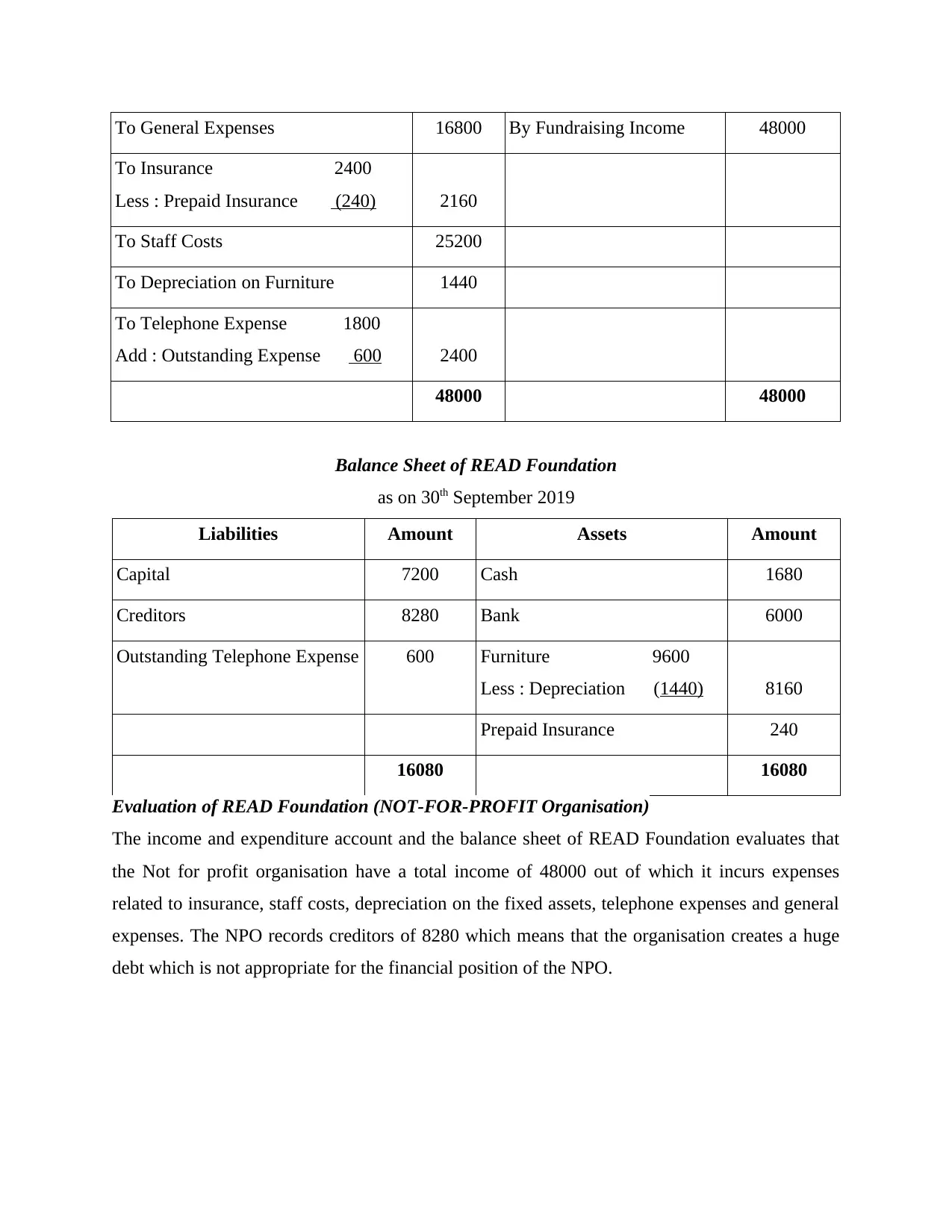
To General Expenses 16800 By Fundraising Income 48000
To Insurance 2400
Less : Prepaid Insurance (240) 2160
To Staff Costs 25200
To Depreciation on Furniture 1440
To Telephone Expense 1800
Add : Outstanding Expense 600 2400
48000 48000
Balance Sheet of READ Foundation
as on 30th September 2019
Liabilities Amount Assets Amount
Capital 7200 Cash 1680
Creditors 8280 Bank 6000
Outstanding Telephone Expense 600 Furniture 9600
Less : Depreciation (1440) 8160
Prepaid Insurance 240
16080 16080
Evaluation of READ Foundation (NOT-FOR-PROFIT Organisation)
The income and expenditure account and the balance sheet of READ Foundation evaluates that
the Not for profit organisation have a total income of 48000 out of which it incurs expenses
related to insurance, staff costs, depreciation on the fixed assets, telephone expenses and general
expenses. The NPO records creditors of 8280 which means that the organisation creates a huge
debt which is not appropriate for the financial position of the NPO.
To Insurance 2400
Less : Prepaid Insurance (240) 2160
To Staff Costs 25200
To Depreciation on Furniture 1440
To Telephone Expense 1800
Add : Outstanding Expense 600 2400
48000 48000
Balance Sheet of READ Foundation
as on 30th September 2019
Liabilities Amount Assets Amount
Capital 7200 Cash 1680
Creditors 8280 Bank 6000
Outstanding Telephone Expense 600 Furniture 9600
Less : Depreciation (1440) 8160
Prepaid Insurance 240
16080 16080
Evaluation of READ Foundation (NOT-FOR-PROFIT Organisation)
The income and expenditure account and the balance sheet of READ Foundation evaluates that
the Not for profit organisation have a total income of 48000 out of which it incurs expenses
related to insurance, staff costs, depreciation on the fixed assets, telephone expenses and general
expenses. The NPO records creditors of 8280 which means that the organisation creates a huge
debt which is not appropriate for the financial position of the NPO.
Paraphrase This Document
Need a fresh take? Get an instant paraphrase of this document with our AI Paraphraser
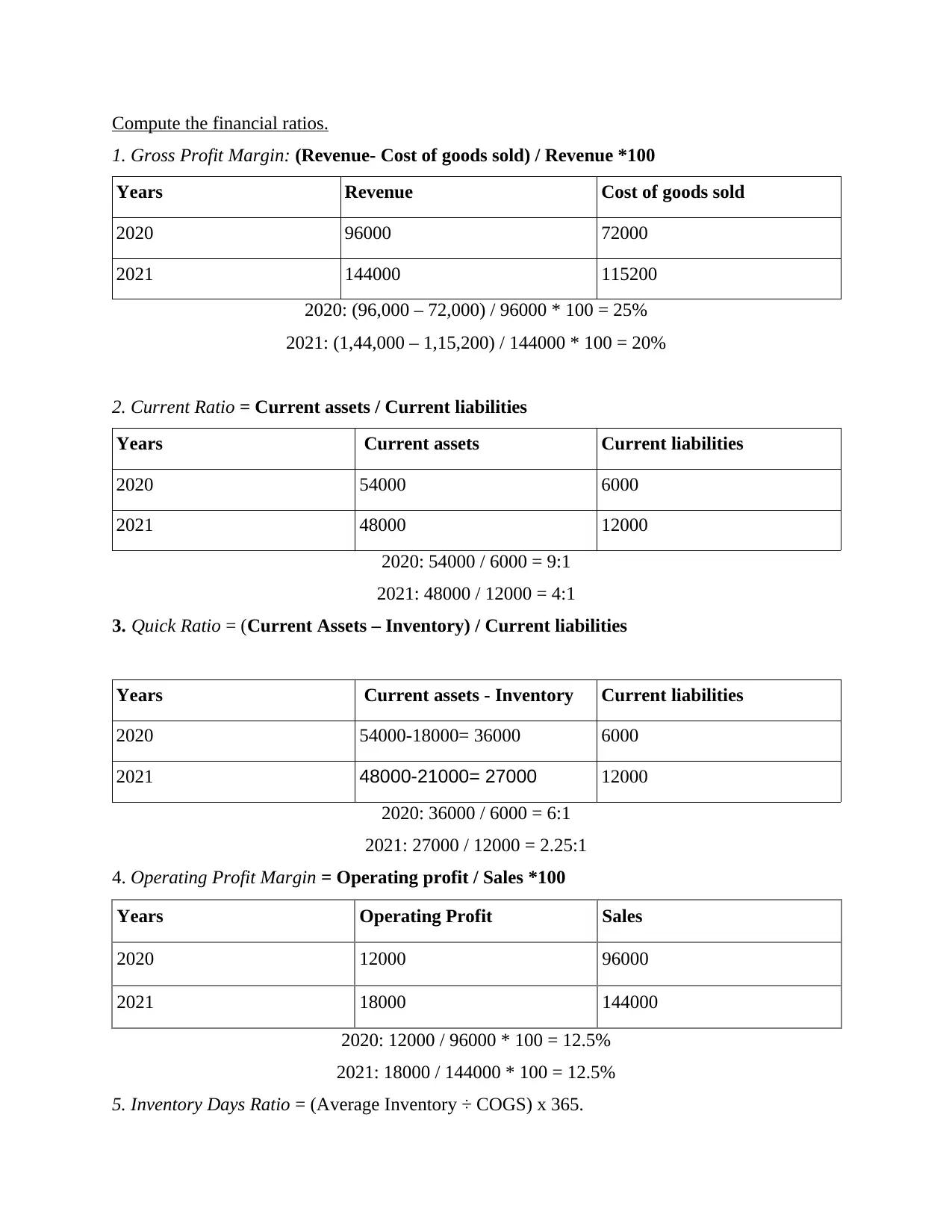
Compute the financial ratios.
1. Gross Profit Margin: (Revenue- Cost of goods sold) / Revenue *100
Years Revenue Cost of goods sold
2020 96000 72000
2021 144000 115200
2020: (96,000 – 72,000) / 96000 * 100 = 25%
2021: (1,44,000 – 1,15,200) / 144000 * 100 = 20%
2. Current Ratio = Current assets / Current liabilities
Years Current assets Current liabilities
2020 54000 6000
2021 48000 12000
2020: 54000 / 6000 = 9:1
2021: 48000 / 12000 = 4:1
3. Quick Ratio = (Current Assets – Inventory) / Current liabilities
Years Current assets - Inventory Current liabilities
2020 54000-18000= 36000 6000
2021 48000-21000= 27000 12000
2020: 36000 / 6000 = 6:1
2021: 27000 / 12000 = 2.25:1
4. Operating Profit Margin = Operating profit / Sales *100
Years Operating Profit Sales
2020 12000 96000
2021 18000 144000
2020: 12000 / 96000 * 100 = 12.5%
2021: 18000 / 144000 * 100 = 12.5%
5. Inventory Days Ratio = (Average Inventory ÷ COGS) x 365.
1. Gross Profit Margin: (Revenue- Cost of goods sold) / Revenue *100
Years Revenue Cost of goods sold
2020 96000 72000
2021 144000 115200
2020: (96,000 – 72,000) / 96000 * 100 = 25%
2021: (1,44,000 – 1,15,200) / 144000 * 100 = 20%
2. Current Ratio = Current assets / Current liabilities
Years Current assets Current liabilities
2020 54000 6000
2021 48000 12000
2020: 54000 / 6000 = 9:1
2021: 48000 / 12000 = 4:1
3. Quick Ratio = (Current Assets – Inventory) / Current liabilities
Years Current assets - Inventory Current liabilities
2020 54000-18000= 36000 6000
2021 48000-21000= 27000 12000
2020: 36000 / 6000 = 6:1
2021: 27000 / 12000 = 2.25:1
4. Operating Profit Margin = Operating profit / Sales *100
Years Operating Profit Sales
2020 12000 96000
2021 18000 144000
2020: 12000 / 96000 * 100 = 12.5%
2021: 18000 / 144000 * 100 = 12.5%
5. Inventory Days Ratio = (Average Inventory ÷ COGS) x 365.
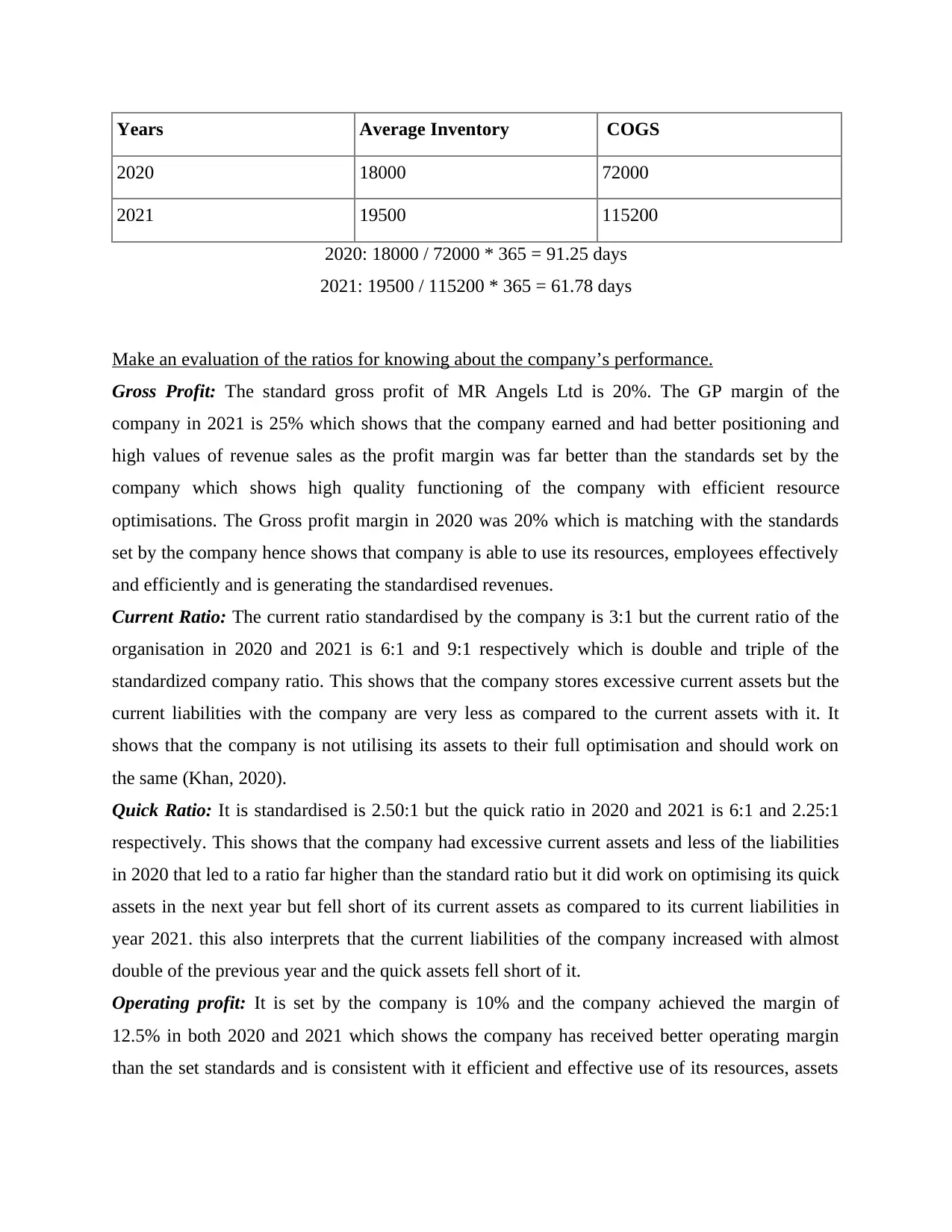
Years Average Inventory COGS
2020 18000 72000
2021 19500 115200
2020: 18000 / 72000 * 365 = 91.25 days
2021: 19500 / 115200 * 365 = 61.78 days
Make an evaluation of the ratios for knowing about the company’s performance.
Gross Profit: The standard gross profit of MR Angels Ltd is 20%. The GP margin of the
company in 2021 is 25% which shows that the company earned and had better positioning and
high values of revenue sales as the profit margin was far better than the standards set by the
company which shows high quality functioning of the company with efficient resource
optimisations. The Gross profit margin in 2020 was 20% which is matching with the standards
set by the company hence shows that company is able to use its resources, employees effectively
and efficiently and is generating the standardised revenues.
Current Ratio: The current ratio standardised by the company is 3:1 but the current ratio of the
organisation in 2020 and 2021 is 6:1 and 9:1 respectively which is double and triple of the
standardized company ratio. This shows that the company stores excessive current assets but the
current liabilities with the company are very less as compared to the current assets with it. It
shows that the company is not utilising its assets to their full optimisation and should work on
the same (Khan, 2020).
Quick Ratio: It is standardised is 2.50:1 but the quick ratio in 2020 and 2021 is 6:1 and 2.25:1
respectively. This shows that the company had excessive current assets and less of the liabilities
in 2020 that led to a ratio far higher than the standard ratio but it did work on optimising its quick
assets in the next year but fell short of its current assets as compared to its current liabilities in
year 2021. this also interprets that the current liabilities of the company increased with almost
double of the previous year and the quick assets fell short of it.
Operating profit: It is set by the company is 10% and the company achieved the margin of
12.5% in both 2020 and 2021 which shows the company has received better operating margin
than the set standards and is consistent with it efficient and effective use of its resources, assets
2020 18000 72000
2021 19500 115200
2020: 18000 / 72000 * 365 = 91.25 days
2021: 19500 / 115200 * 365 = 61.78 days
Make an evaluation of the ratios for knowing about the company’s performance.
Gross Profit: The standard gross profit of MR Angels Ltd is 20%. The GP margin of the
company in 2021 is 25% which shows that the company earned and had better positioning and
high values of revenue sales as the profit margin was far better than the standards set by the
company which shows high quality functioning of the company with efficient resource
optimisations. The Gross profit margin in 2020 was 20% which is matching with the standards
set by the company hence shows that company is able to use its resources, employees effectively
and efficiently and is generating the standardised revenues.
Current Ratio: The current ratio standardised by the company is 3:1 but the current ratio of the
organisation in 2020 and 2021 is 6:1 and 9:1 respectively which is double and triple of the
standardized company ratio. This shows that the company stores excessive current assets but the
current liabilities with the company are very less as compared to the current assets with it. It
shows that the company is not utilising its assets to their full optimisation and should work on
the same (Khan, 2020).
Quick Ratio: It is standardised is 2.50:1 but the quick ratio in 2020 and 2021 is 6:1 and 2.25:1
respectively. This shows that the company had excessive current assets and less of the liabilities
in 2020 that led to a ratio far higher than the standard ratio but it did work on optimising its quick
assets in the next year but fell short of its current assets as compared to its current liabilities in
year 2021. this also interprets that the current liabilities of the company increased with almost
double of the previous year and the quick assets fell short of it.
Operating profit: It is set by the company is 10% and the company achieved the margin of
12.5% in both 2020 and 2021 which shows the company has received better operating margin
than the set standards and is consistent with it efficient and effective use of its resources, assets
⊘ This is a preview!⊘
Do you want full access?
Subscribe today to unlock all pages.

Trusted by 1+ million students worldwide
1 out of 17
Related Documents
Your All-in-One AI-Powered Toolkit for Academic Success.
+13062052269
info@desklib.com
Available 24*7 on WhatsApp / Email
![[object Object]](/_next/static/media/star-bottom.7253800d.svg)
Unlock your academic potential
Copyright © 2020–2025 A2Z Services. All Rights Reserved. Developed and managed by ZUCOL.



